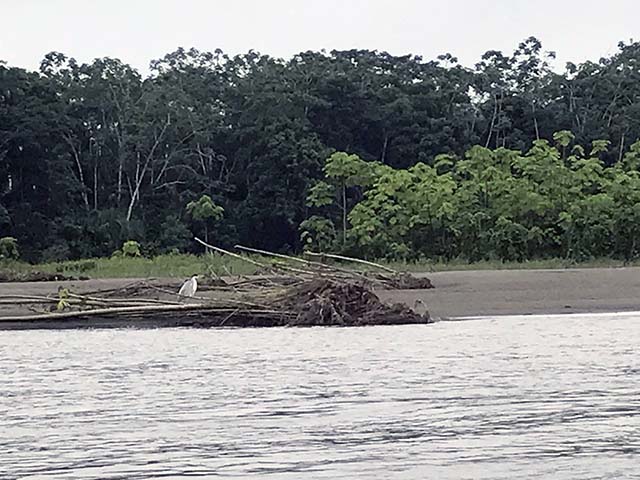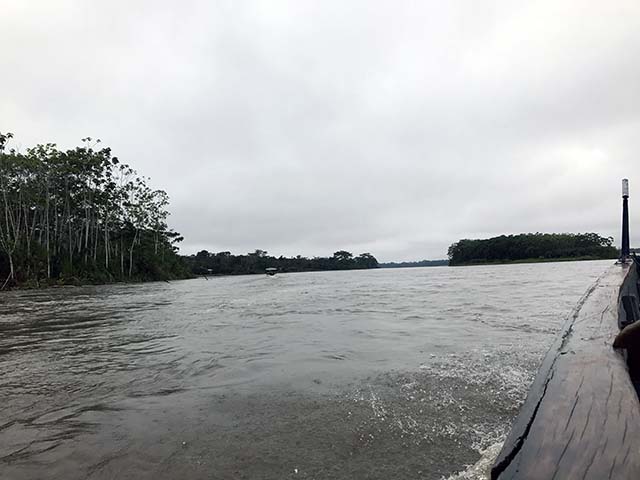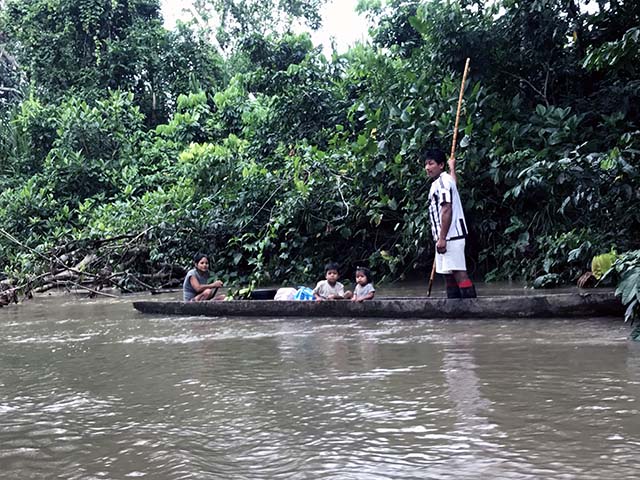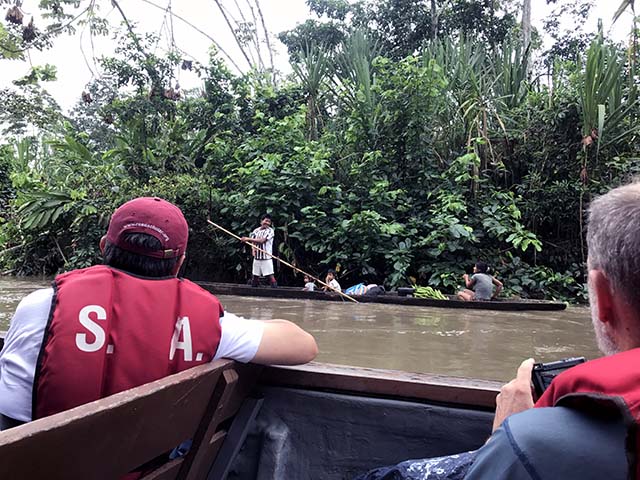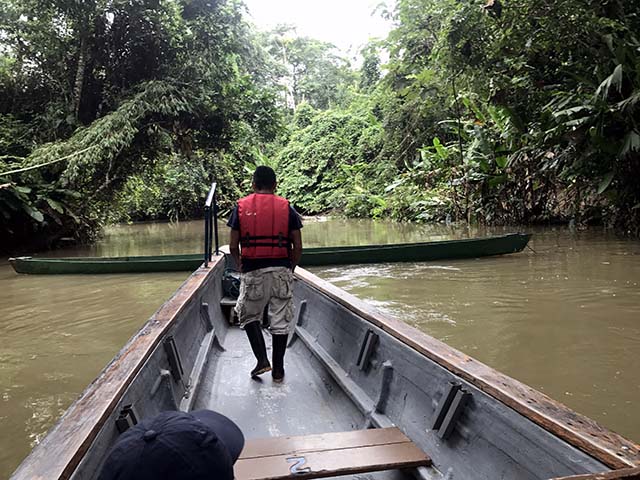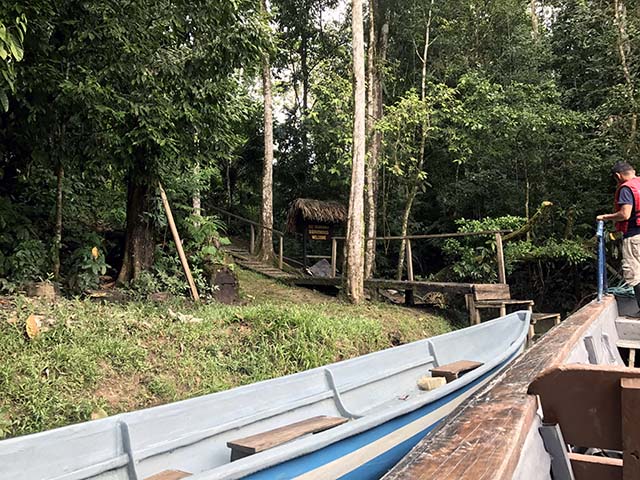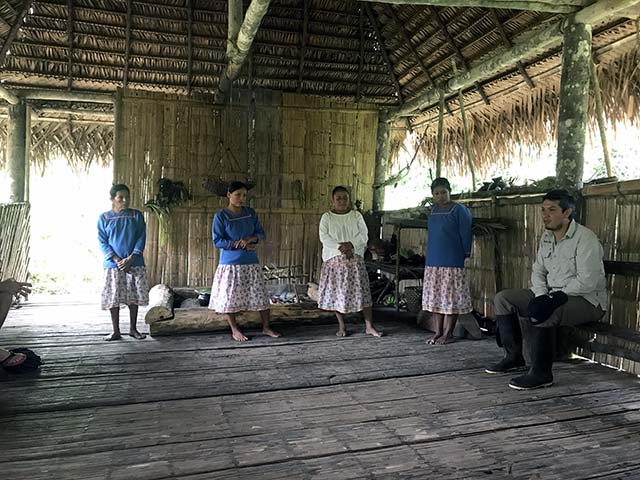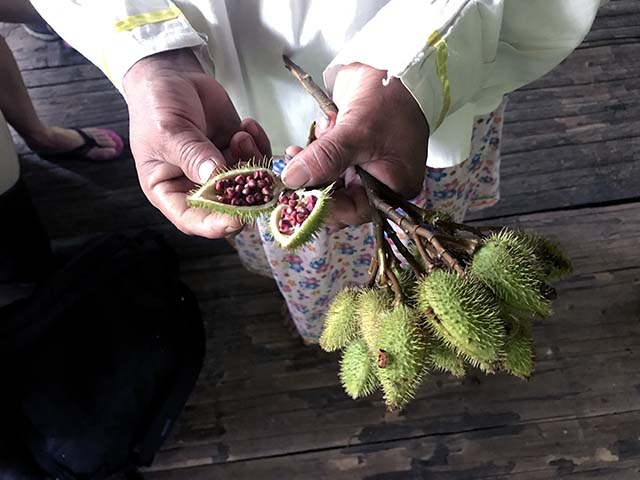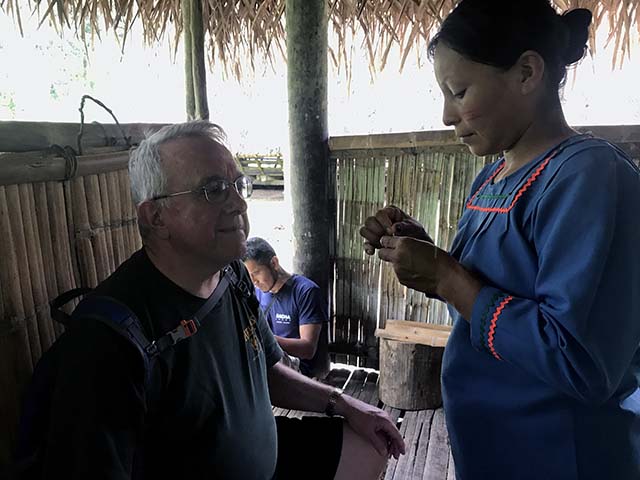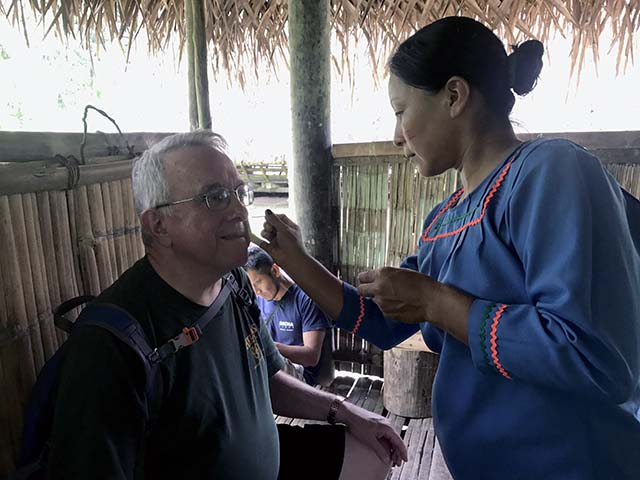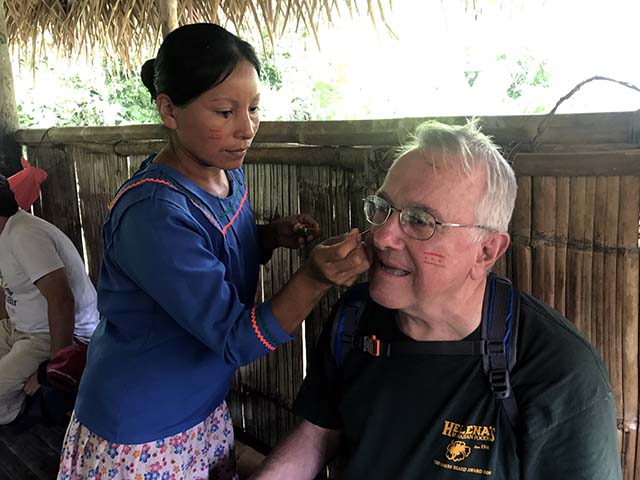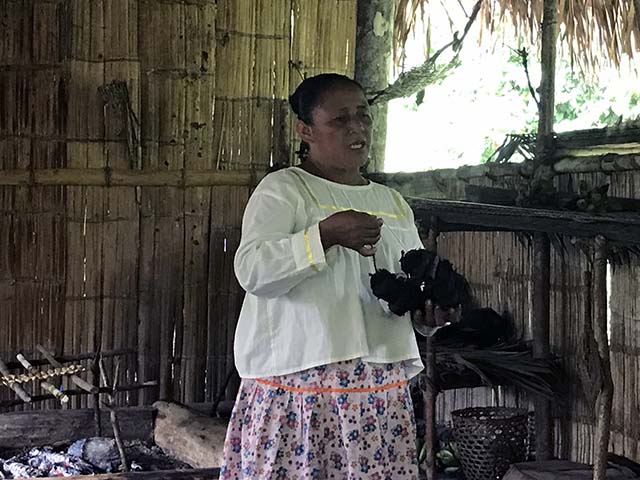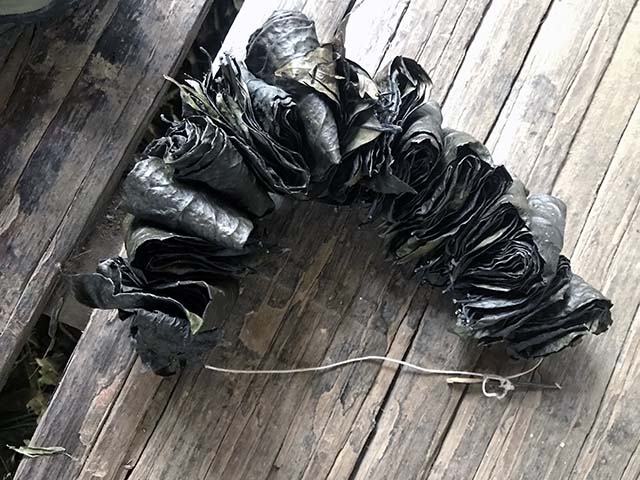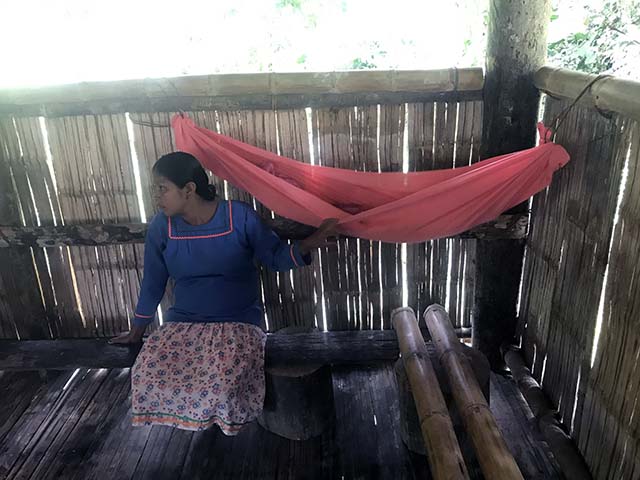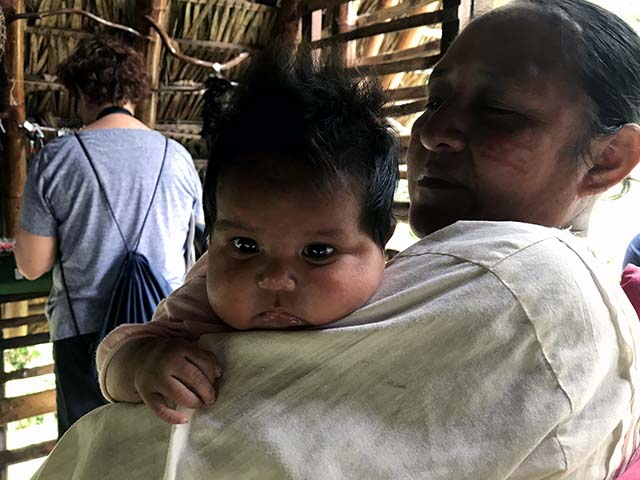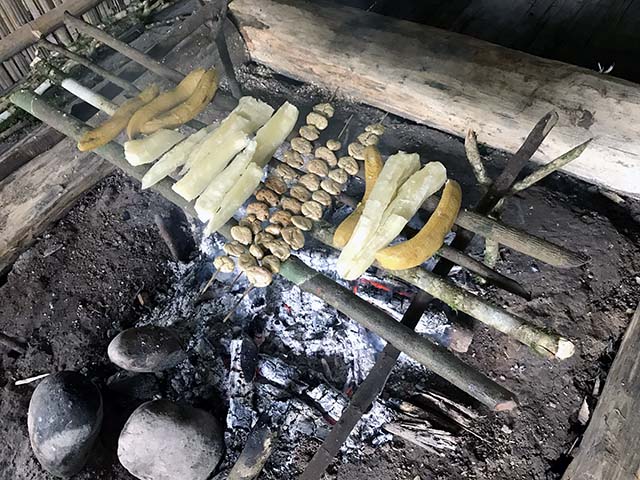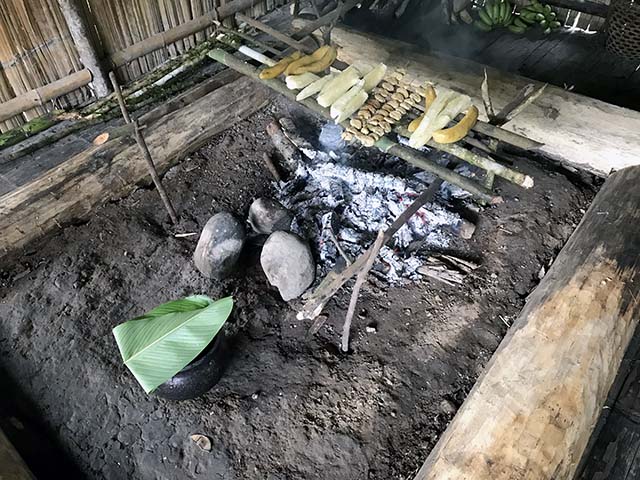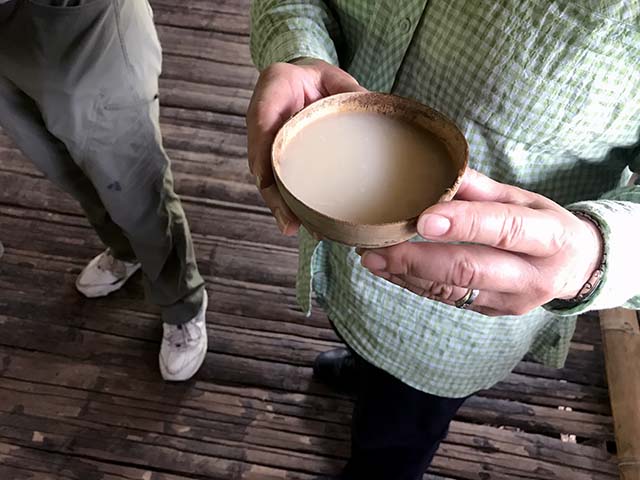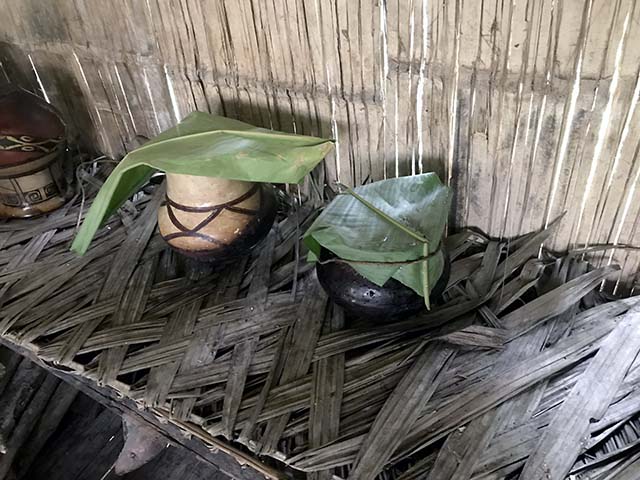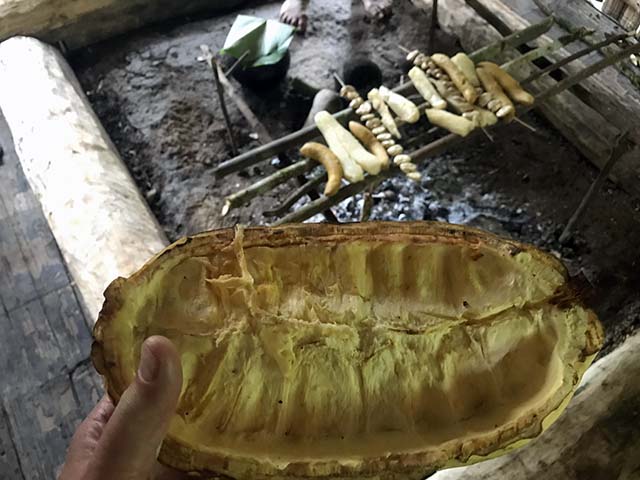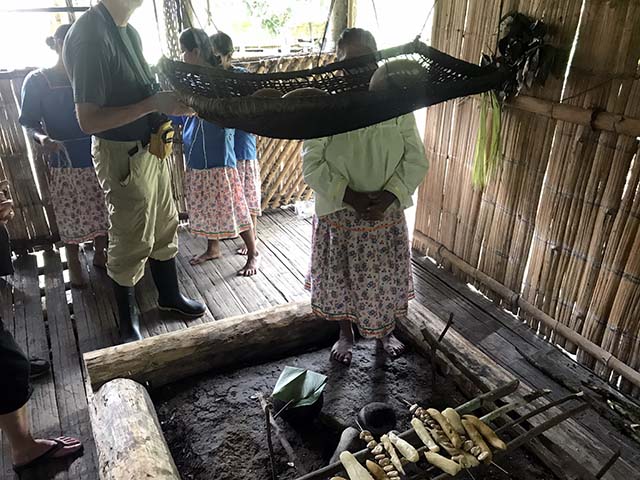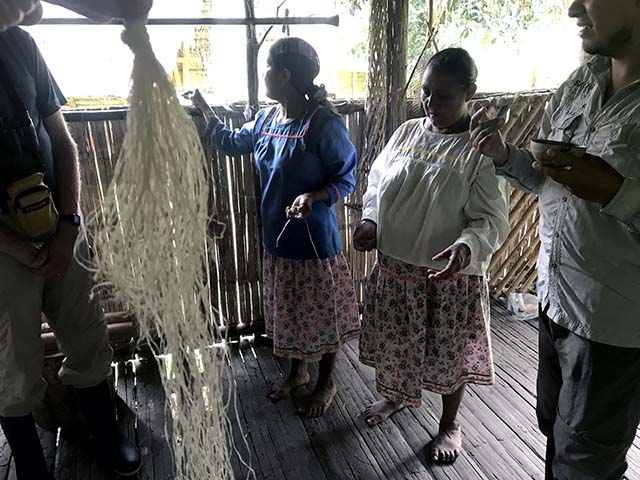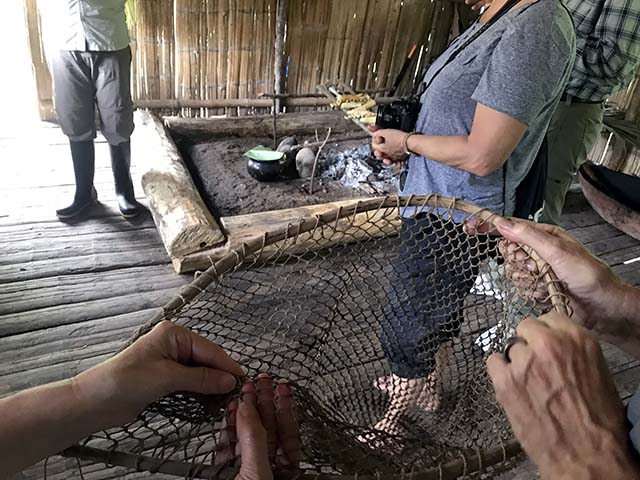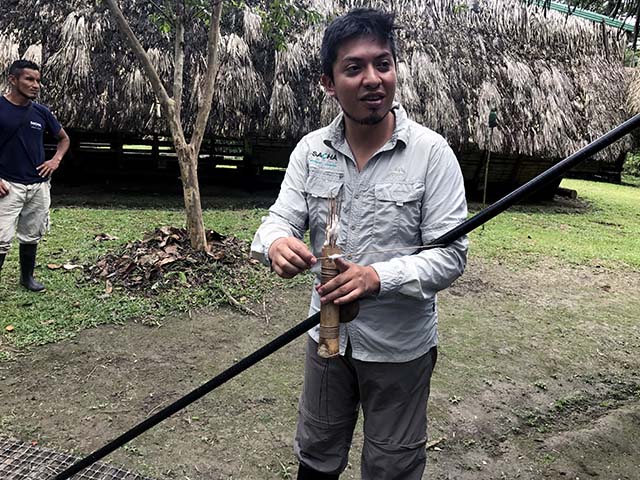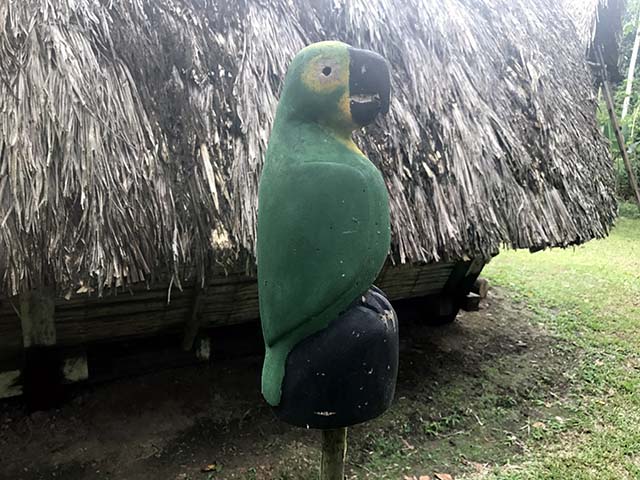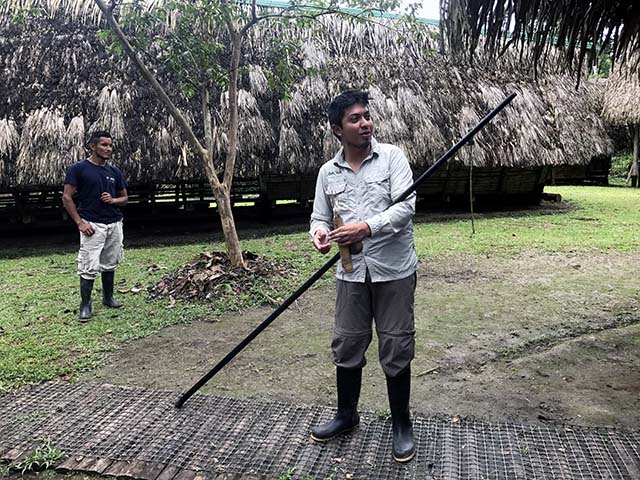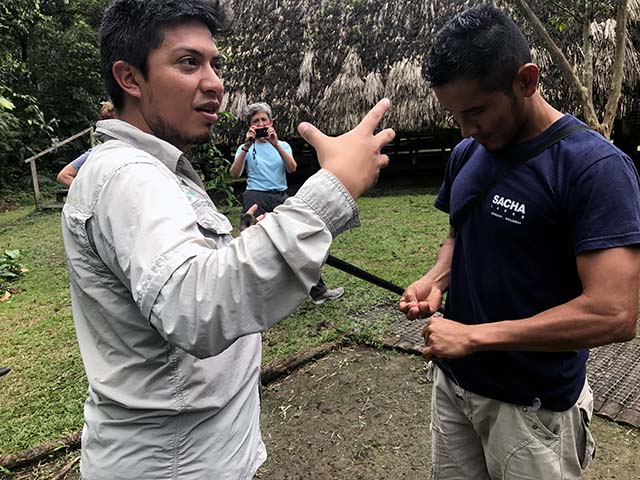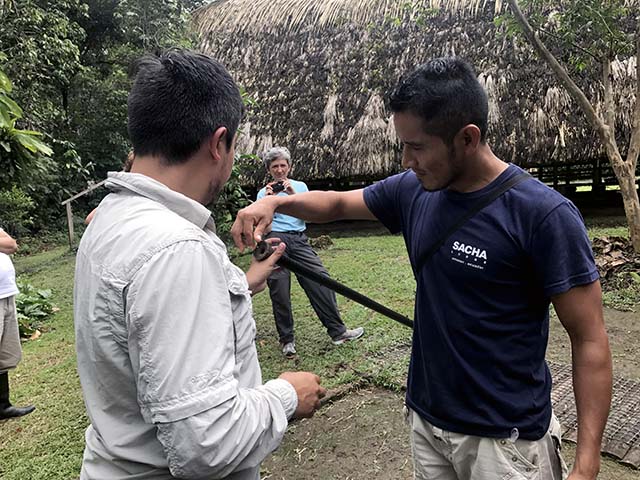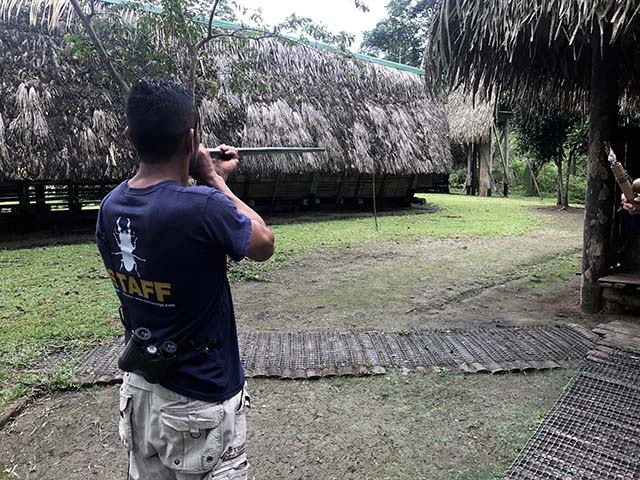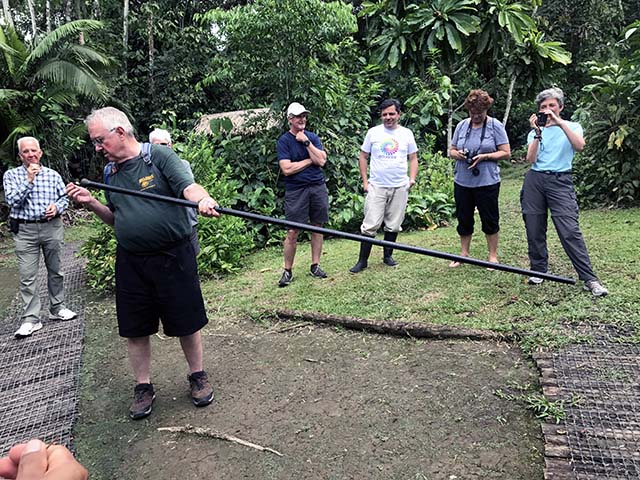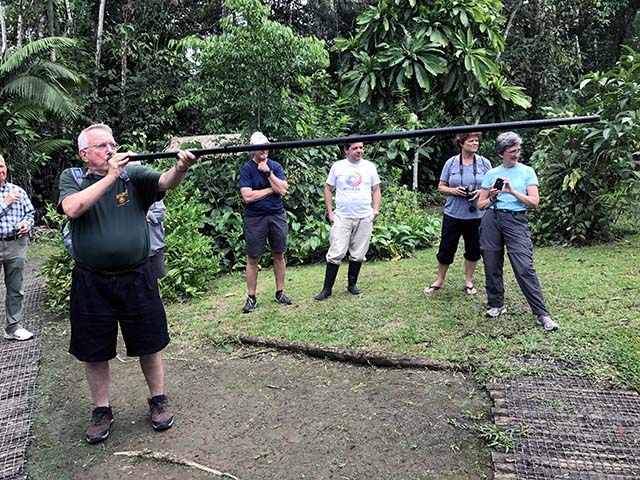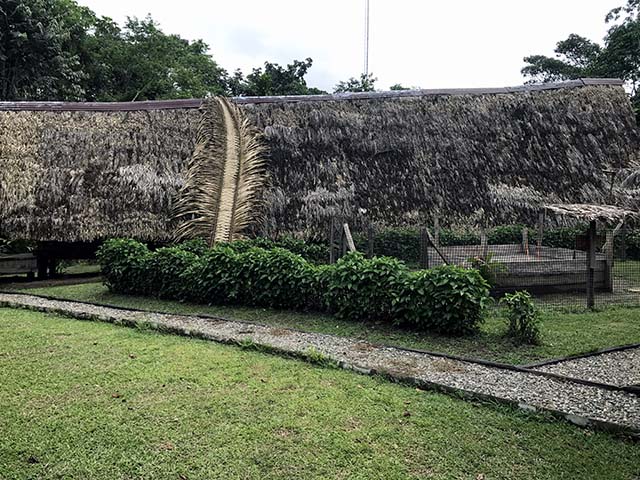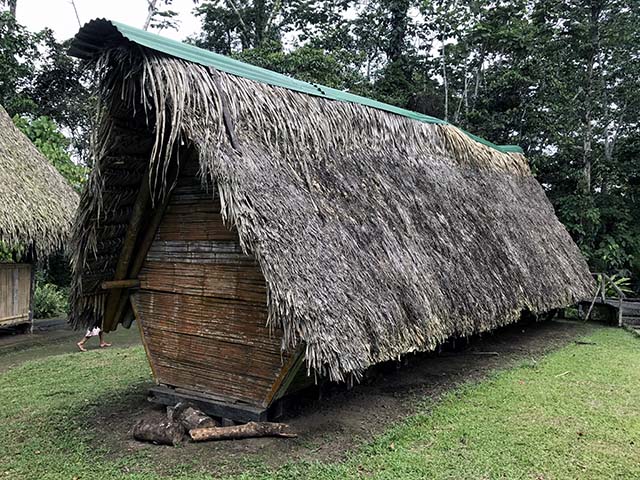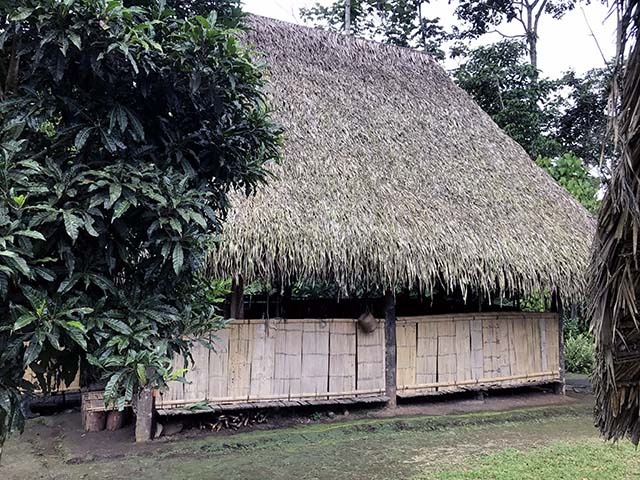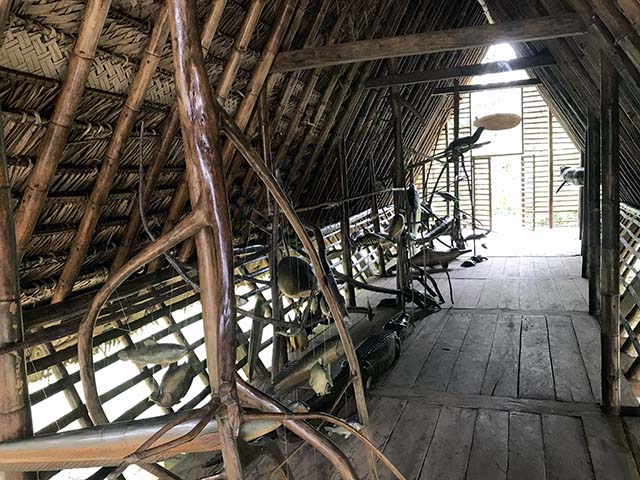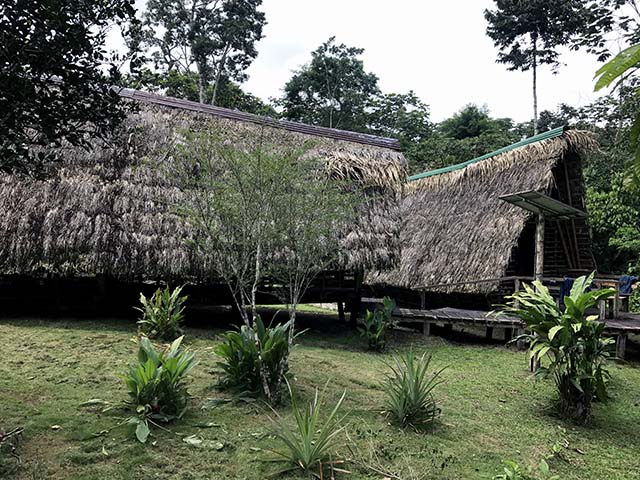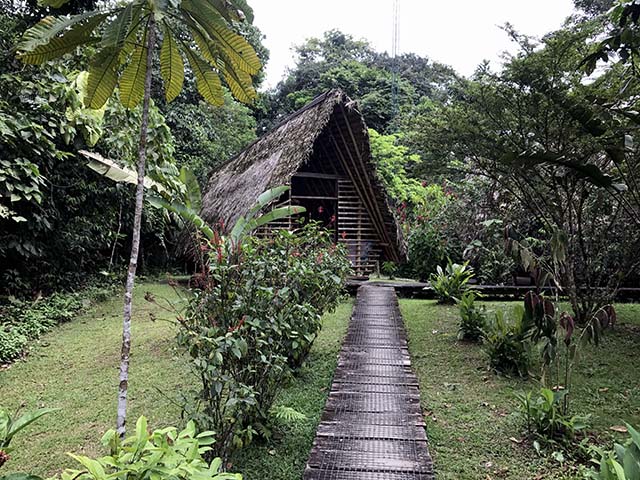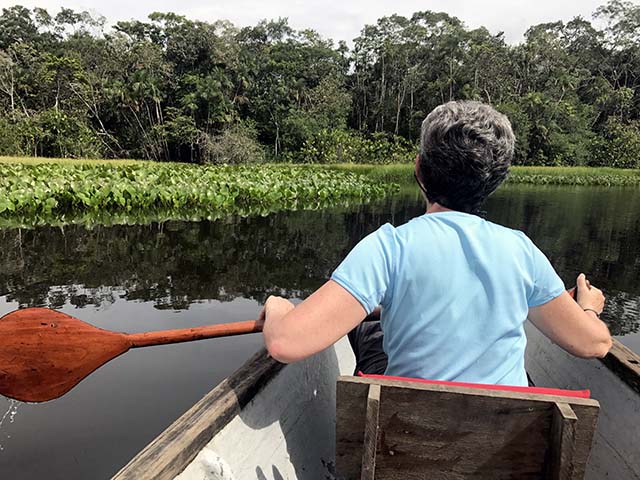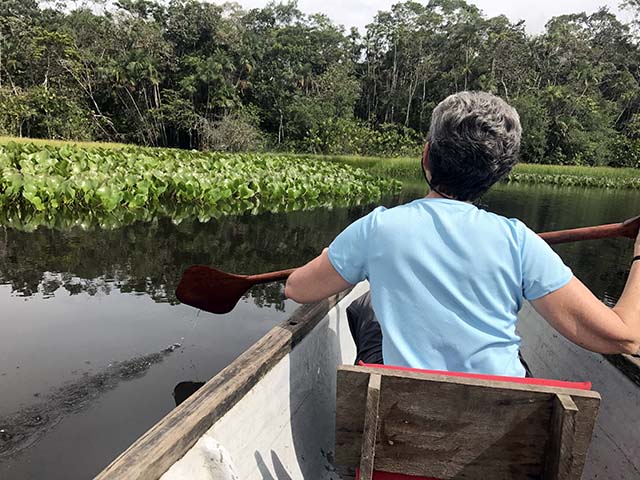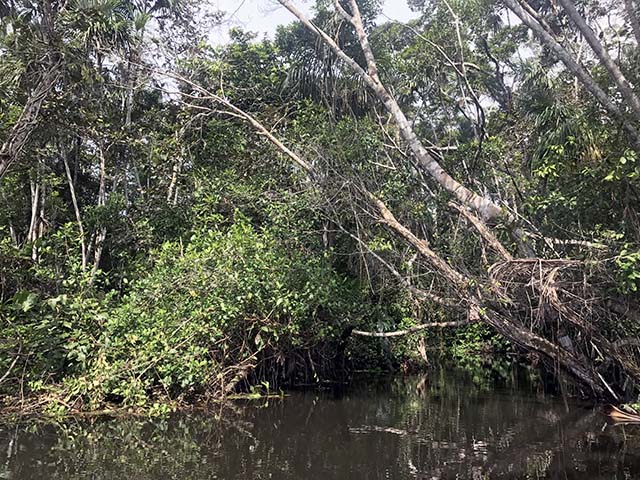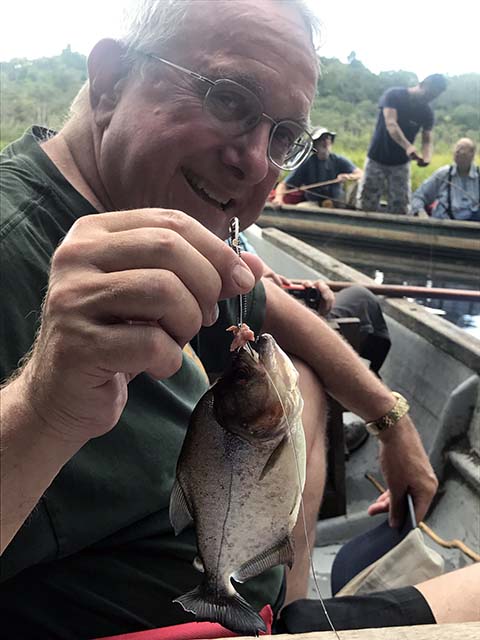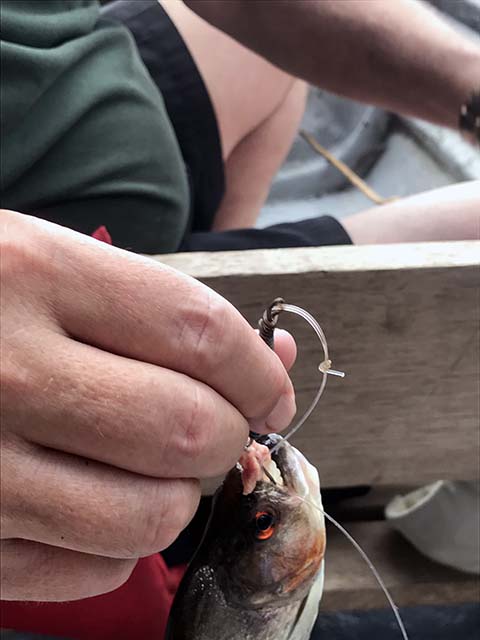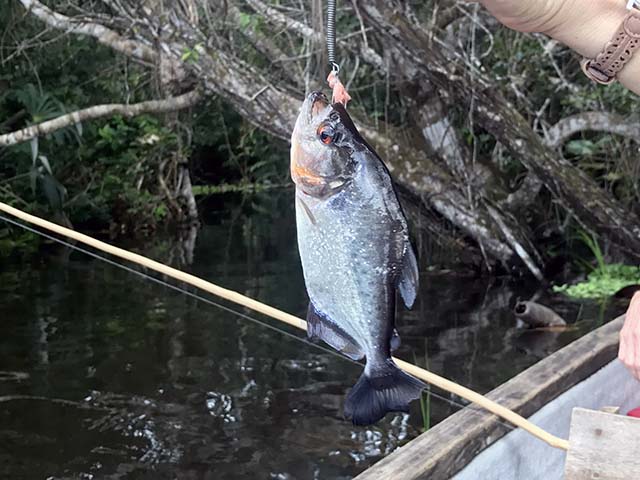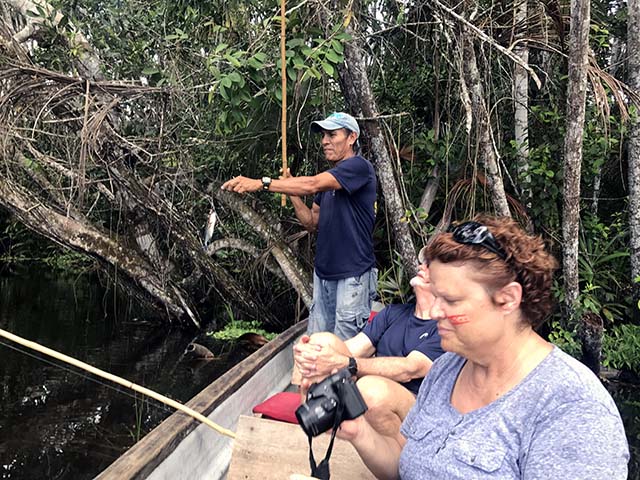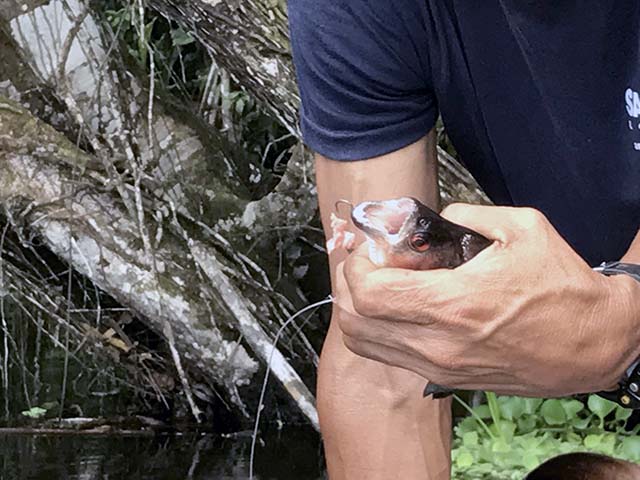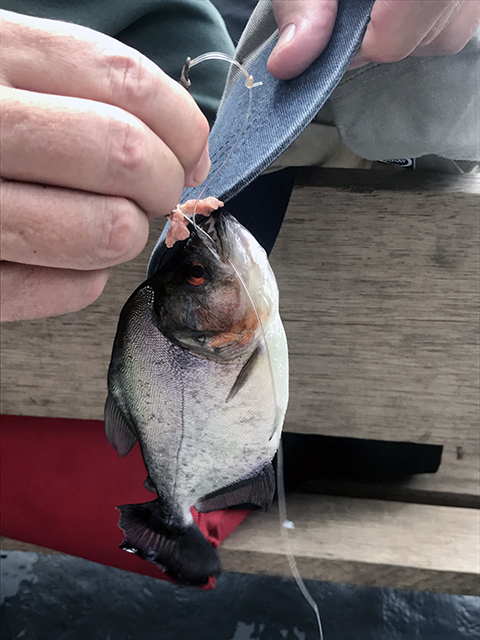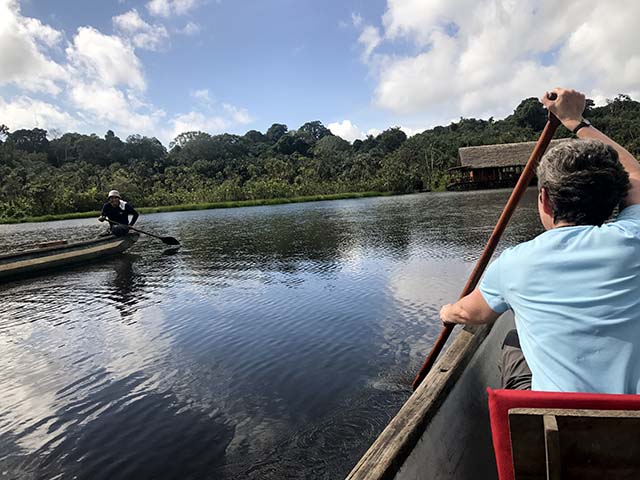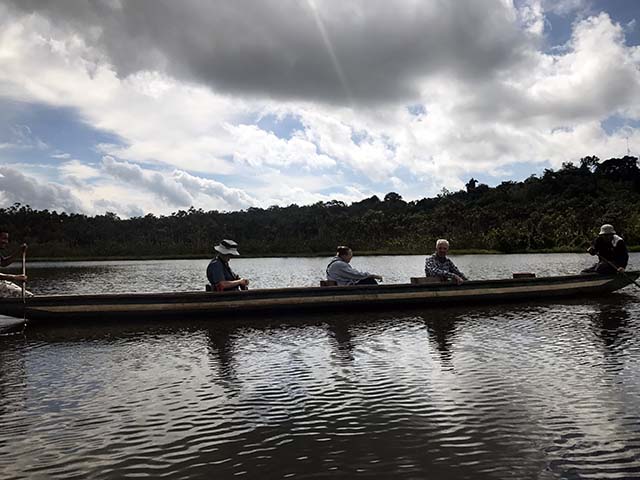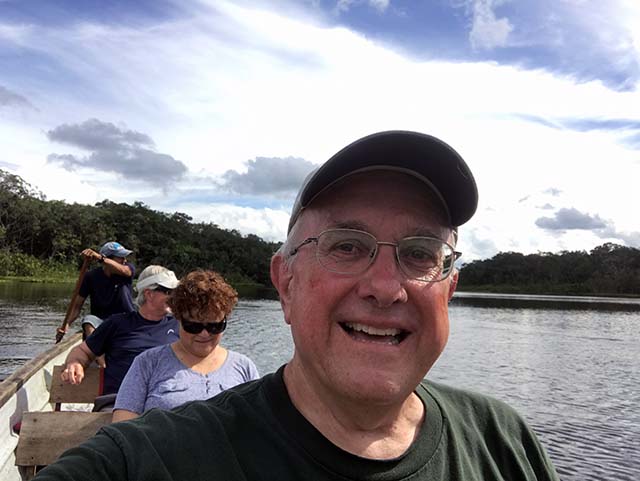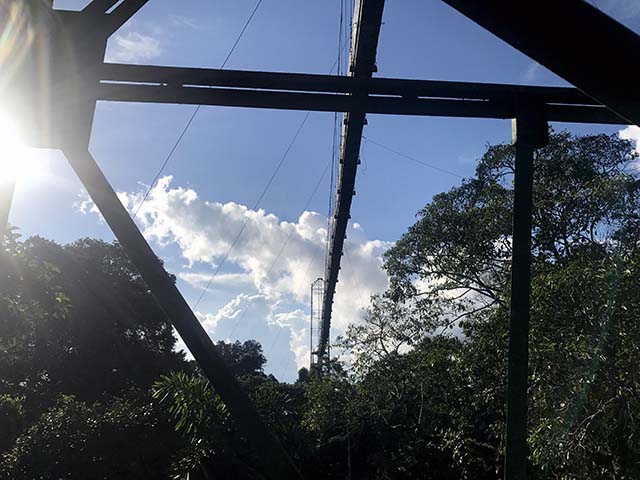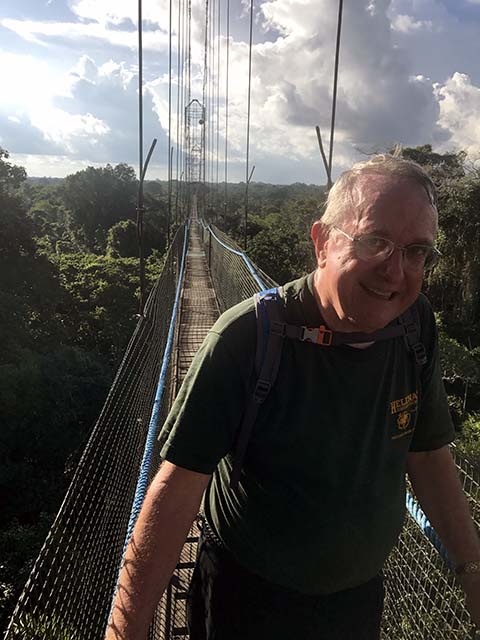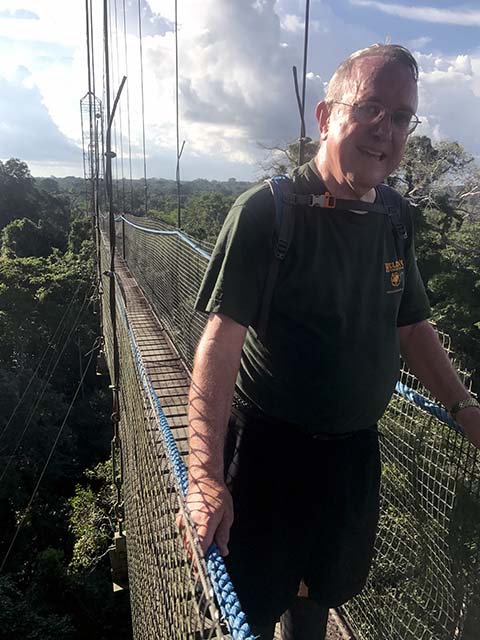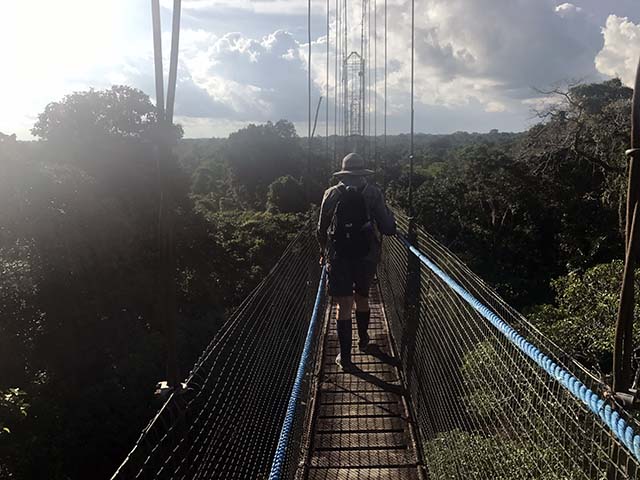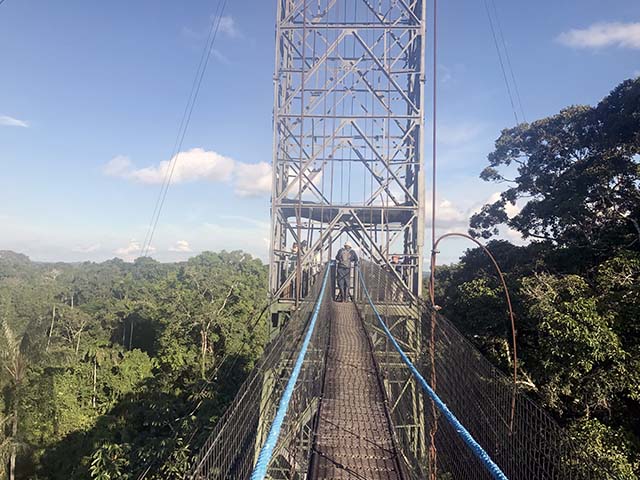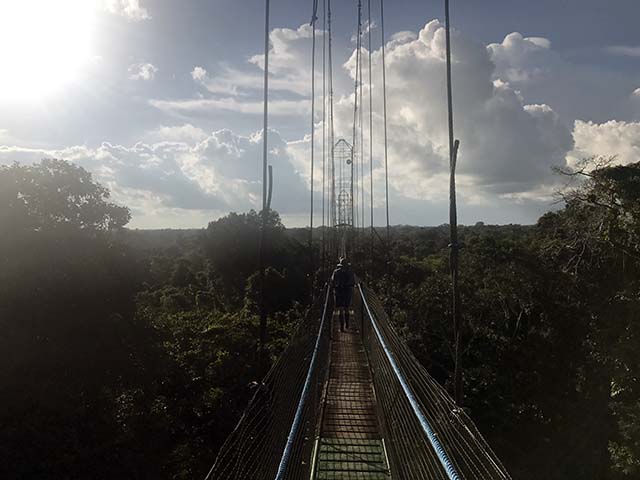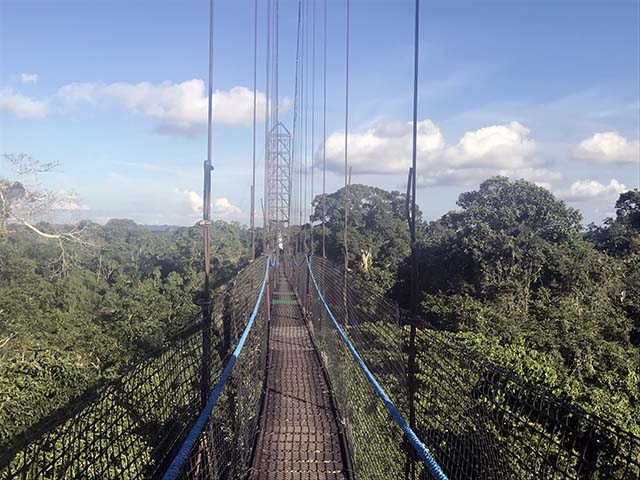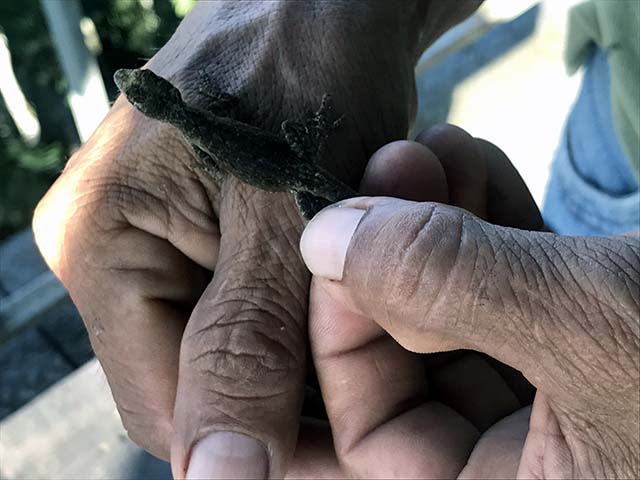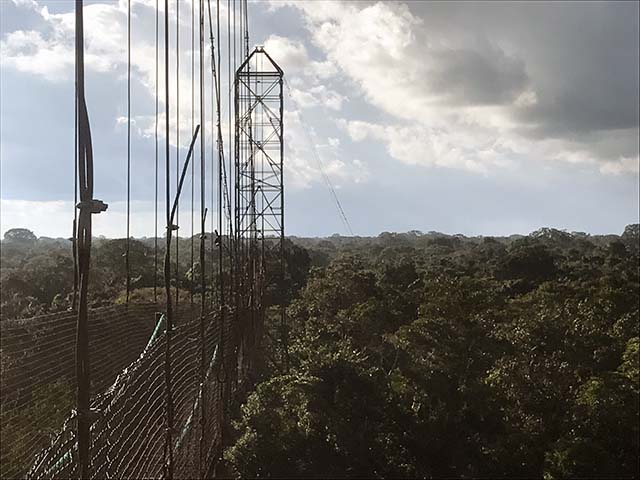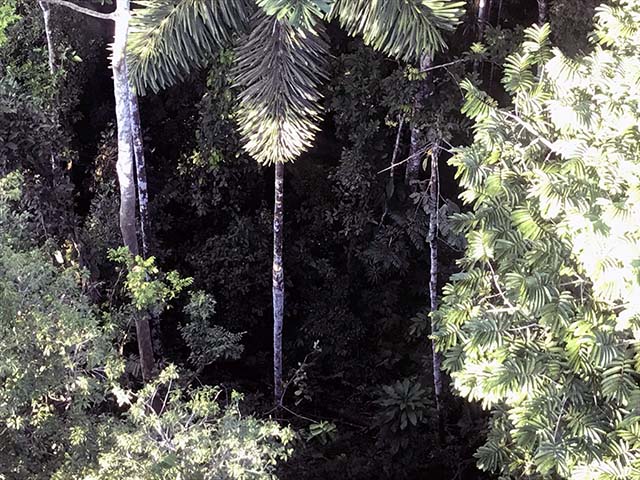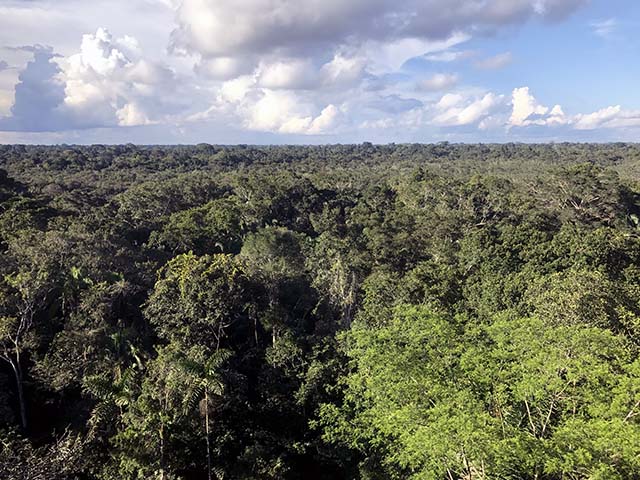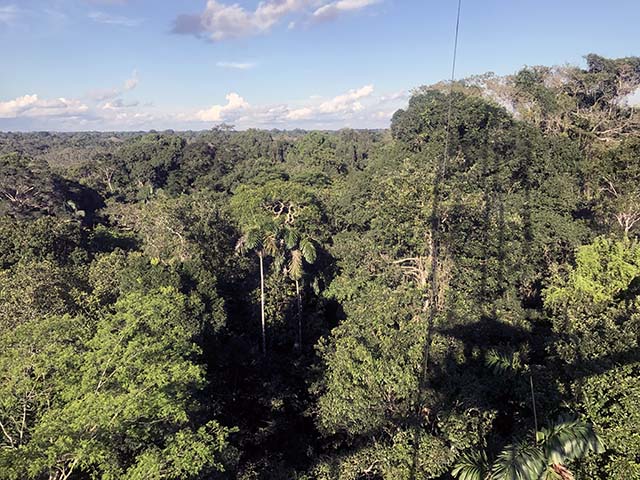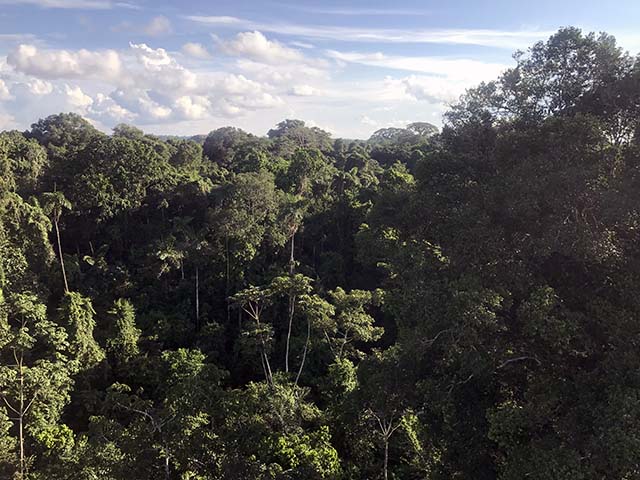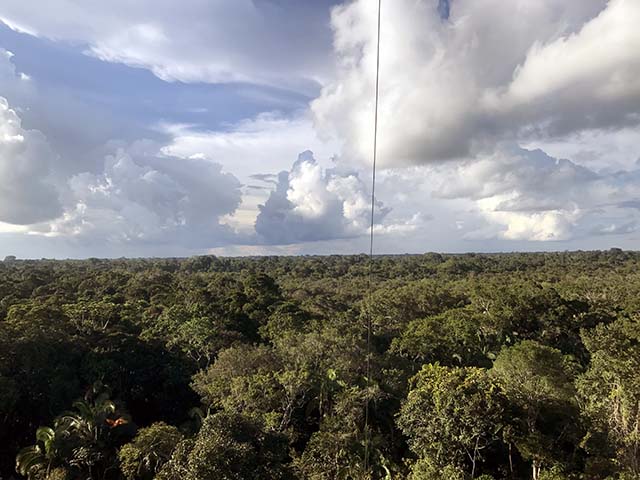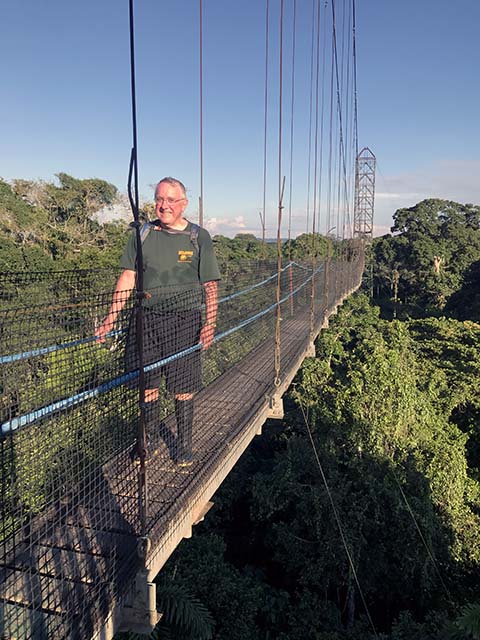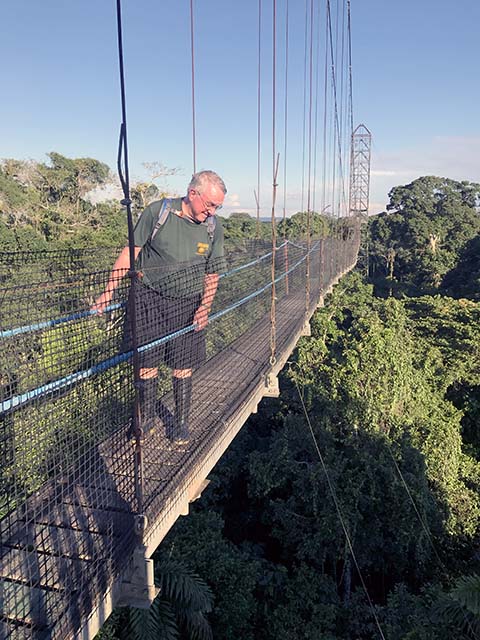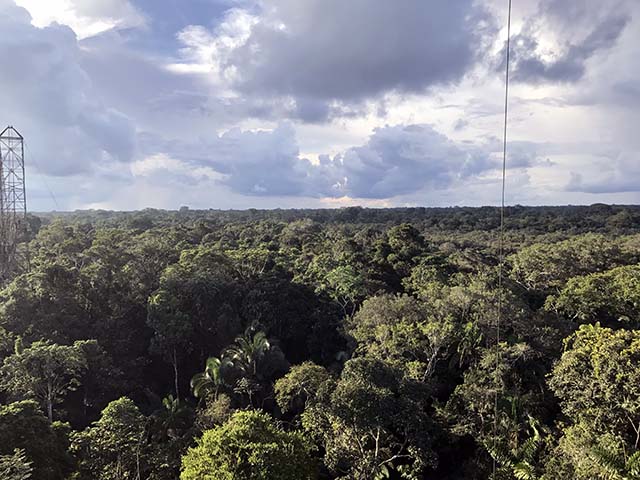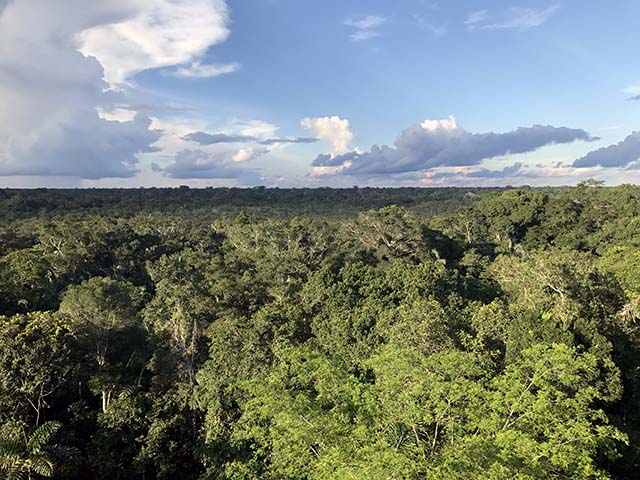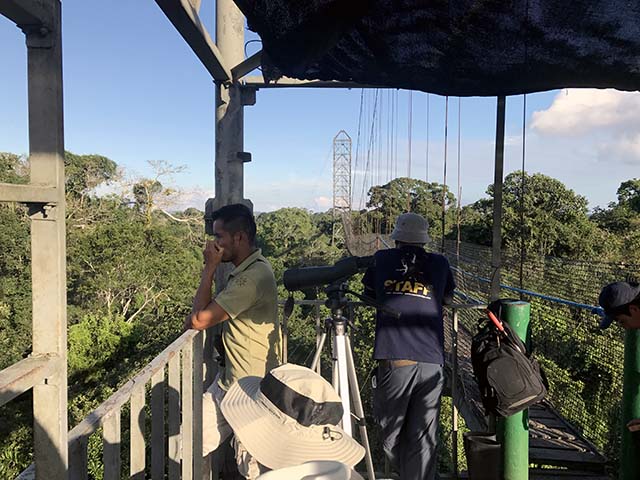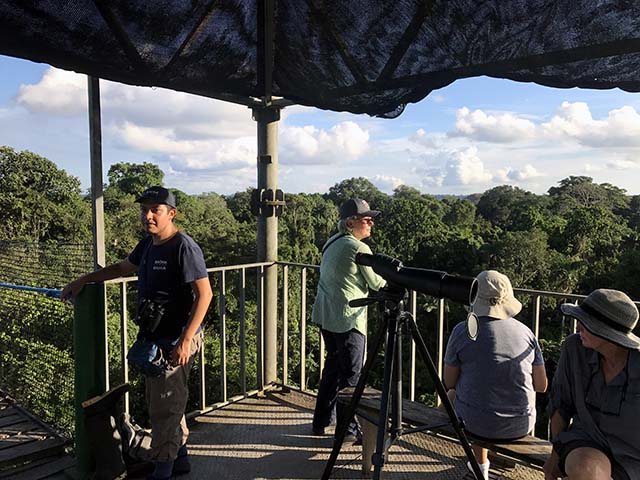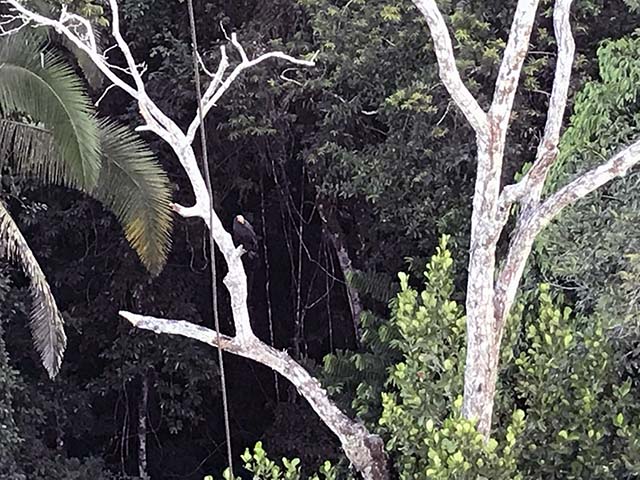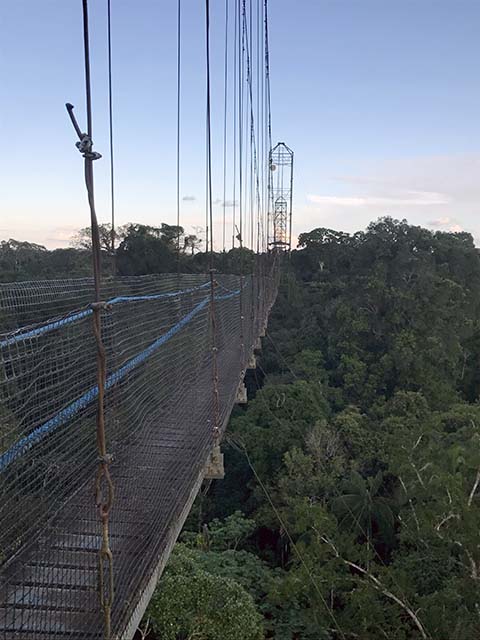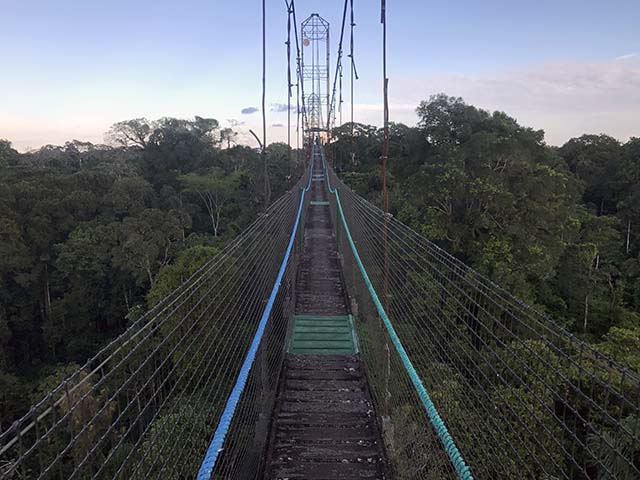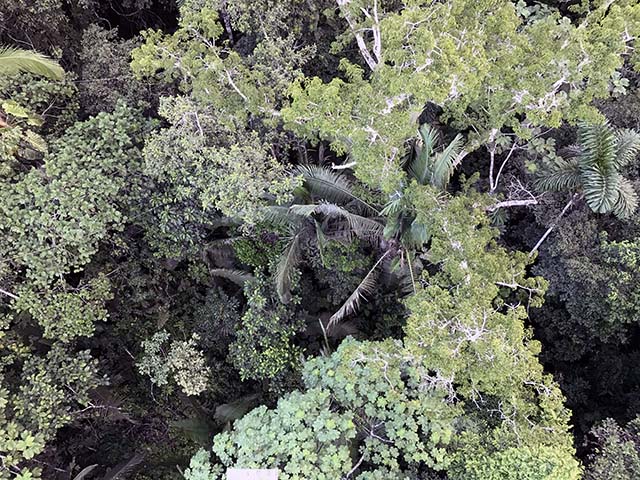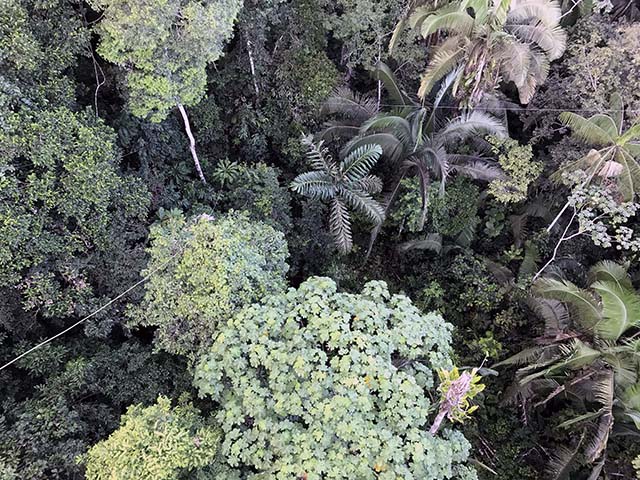|
Up before dawn, quick breakfast, trek through the jungle via canoe and feet in Wellington boots, and now ... we're headed down the Napo River to see parrots.
And we'll be traveling in an open motorized canoe. And it's starting to rain. And Daniel says if it rains we won't see parrots. Things are getting off to a less-than-auspicious start.
Daniel's not worried, though.
And about an hour later, or what seemed like an hour later considering that rainstorm, we arrived at the parrot lick. But why do the parrots like to eat this exposed clay? Some foods eaten by [parrots] in certain regions in the wild are said to contain toxic or caustic substances which they are able to digest. It has been suggested that parrots and macaws in the Amazon Basin eat clay from exposed river banks to neutralize these toxins. In the western Amazon hundreds of macaws and other parrots descend to exposed river banks to consume clay on an almost daily basis – except on rainy days. Well wasn't Daniel surprised? It had rained and still there were parrots everywhere. And another thing -- Daniel called these birds "parrots," but I do believe what we may really have seen were parakeets as described here.
This is an internet image showing parakeets at a clay lick on the Napo River. These birds certainly look like the birds we saw.
Watch the parrots lick that clay.
Eduardo has seen it all before, but still I think he enjoyed this as much as the Road Scholars.
Look over there! A bird!
Now we're headed even deeper into the jungle, to a small park/demonstration area maintained by female members of a Kichwa tribe.
Daniel Makes a Joke: Paracondo
Our first encounter with (other than our native guides) the indigenous people of the Amazon. Napu runas or Amazonian Kichwas are a grouping of indigenous Kichwa peoples in the Ecuadorian Amazon, with minor groups across the borders of Colombia and Peru. Amazonian Kichwas consists of two different ethnic peoples, Napu-Kichwa (living in the Napo and Sucumbíos provinces, with some parts of their community living in Colombia and Peru) and Canelo-Kichwa (also referred to as Kichwa del Pastaza, living in the Pastaza Province). There are approximately 419 organized communities of the Amazonian Kichwas. The basic socio-political unit is the ayllu (made up by a group of families). The ayllus in turn constitute territorial clans, based on common ancestry. These groups speak different dialects of Kichwa, such as Bobonaza (in the Napo province), Tena (in Tena canton, closely related to the Andean Kichwa) and Limoncocha. There are also some groups amongst the Amazonian Kichwa who speak Shuar. After a powerful protest of the Amazonian Kichwas held in Pastanza in 1992, the Ecuadorian state handed over the rights to 1,115,000 ha of land for their use. And while I'm at it -- another thing: Is it Kichwa or Quichua or Quechua or something else, and which is the people and which is the language? I'm still not sure, but I did find this.
Just a local family taking bananas to market. The kids seemed fascinated by the tourists on the big boat.
Uh oh -- there seems to be a blockade in the river. (Just to help with bearings, that's the mainland on the left and an island in the Napo on the right. The main channel of the Napo is over on the other side of the island.) Here's how this works: that long canoe is tied to both banks with ropes. If you're on one side and you want to go to the other, you just grab the rope, pull the canoe to the riverbank, step in, walk carefully to the other end of the canoe, grab the other rope and pull yourself to the other riverbank. Simple, right? This wasn't much of an obstacle for our guides, who had been this way before. With a little quick maneuvering, the canoe was soon turned out of the way and we crossed over a rope with no incident and on we continued.
. Now we've arrived at the Yaku Kawsay Interpretation Center where we'll meet some local Kichwa people.
Guess what "Alli Shamushka" means in the native Kichwa language spoken around here? Go on, guess.
These ladies are bidding us Alli Shamushka and Daniel is interpreting. The local Kichwa people have set up this interpretation center only after a good bit of soul-searching. Different Kichwa subgroups had to decide -- "Do we want to be left alone, to continue living in our traditional ways, hunting and gathering our traditional foods, building our homes of palm wood and thatch, spending our days stark naked, or -- Do we want to give up all that, put on some clothes, and make good money telling tourists about how things used to be? Some have chosen the old ways and the Ecuadorian government has set aside a large tract of Amazonian rain forest in which they now live unmolested. Tourists don't see them, and they don't see tourists. This group, on the other hand, has chosen the tourist route, but the funny thing is, the men of the tribe think catering to tourists is women's work. So you don't see men around here. Whatever. These ladies made us feel right at home and their presentation was terrific.
See these pretty little red berries?
They make paint. And what do we do with the paint, you ask?
Bill's about to find out.
Hold still, tourist.
There...perfect. Now you are a great hunter. Or something.
See these cacao leaves? We boil them to make tea and we drink gallons of the stuff.
Why drink the tea? Oh, it's stimulating. We can work all day. Really? Can we try? No.
Aww...lookit the little papoose. As I understood it, the little one was only a few days old.
When the baby would get restless, mama would give the cradle a rock.
And eventually grandma let us meet the little one.
Mmmm...our mid-morning snack is roasting over an open fire inside the house. That's plantain, yucca and cacao beans. I have to admit this was the first time I have ever actually LIKED plantains, and I've had them prepared lots of ways. But the highlight of the meal were the cacao beans. Yummy!
CJ learns how to prepare yucca.
Won't be long now.
Bill can't stop showing off his manly face paint.
And for our beverage we have, wait ... what did you say this is? Chicha? And it's alcoholic? And to make it you do what? You SPIT in it to make it start fermenting? Oh, but you promise nobody has spit in this...you do promise, right? OK, just a little sip...um, er, thanks!
Fermenting chicha on the kitchen shelf. Thanks, I believe I'll have bottled water.
Smelling good now, even with all the smoke in the room.
The cacao beans came from this cacao pod. I knew you could make chocolate from them, but I had no idea you could roast them on an open fire and they'd taste like ... well, like big soft, bland but tasty cashews.
You have a warming oven at home? Well, the Kichwas have a warming hammock.
Now we're learning how they weave baskets, backpacks, and so forth.
The fiber comes from palm trees and it's quite sturdy. Just don't get it wet.
Daniel is explaining the art of shooting game with a blowgun.
The target is this poor parrot.
He says you have to hold your mouth right.
And then he turns the duties over to Walter, the native guide who knows what he's doing.
Walter is an old hand at this.
Bullseye!
OK, let's let the 70-year-old fat gringo have a try.
Actually he didn't do too bad on his first shot. Missed the target, but he was holding his mouth right and the dart ended up in the thatched roof behind. Let's not talk about his second shot.
Mmmm...indigenous snacks laid out for the mighty hunters.
The Road Scholars prepare to feast. And they declared it good.
Let's look around the property before we leave.
That's an indigenous structure.
So's that.
There's a nice display of wooden models of local fish inside. Even an anaconda.
Well, I like indigenous structures as much as the next guy.
But that's enough. And with that, we loaded up the big motorized uncovered canoe, headed back the way we came, found the Sacha Lodge dock on the Napo, put our boots back on, trudged back through the jungle, got in our canoes, paddled back to the lodge, freshened up, had lunch, and then went fishing. For piranha.
And Nancy is paddling this time. Bill is still delighted somebody else wants to do this.
Hey Nancy, that's a strange looking paddle you've got there. How about holding it up so I can take a picture?
Thanks.
So...this is a piranha fishing hole? Yep, and in fact there were plenty of hungry fish here. You'd bait your hook with a piece of bloody beef (if it wasn't beef I don't know what it was and I didn't ask) and drop the hook in the water and pretty soon something would grab it and steal your bait so quickly you couldn't set the hook no matter how hard you jerked. And if the blood washed out of the bait before the fish could steal it, those bloodthirsty piranhas would just lose interest. We fished and we fished and we fed bait to the piranhas until you'd think they'd be full by now, but none of the Road Scholars caught anything. We were getting hot and sweaty and frustrated, and then....
One of the native guides caught one and we passed it around so we could all have our pictures taken with it as though we'd caught it ourselves. There he is, Bill, the big fisherman.
Hey, that thing's got teeth!
Sharp teeth!
Is it time to go back to the dock?
Nope, the other guide has caught one.
With even sharper teeth.
Bill wants to get a better look at the teeth on that thing, but he's not about to stick his finger in its mouth. So he gently encourages a smile using the brim of his hat. You know, it looks kinda like a bream, so I wonder if it's good to eat? The answers to that are mixed: YEA: "I actually had piranhas in Ecuador. We fished them together with our jungle guides and fried them afterwards. The jungle guides explained that we should only keep the ones with the white bellies because the ones with the red bellies are full of parasites and are therefore not tasty and even harmful. I really liked piranhas. There was not much to eat because they are very boney but the little bit of meat they had was very good." NAY: "I am unlucky to have eaten them once. They are very bloody, like a fishy, pungent version of a raw steak. I ate them smoked, which is apparently one of the best ways to hide their fishy smell and taste. It wasn’t enough. They are also really bony. The bone structure, as has been mentioned, is more like a mammal’s than a fish’s."
They told us Hollywood has given the poor little piranha fishies a bad reputation, that they don't bother swimmers in the lake.
Anybody want to get out and swim? I didn't think so.
That was fun! Now let's go on another hike! Everybody wants to hike now, right? Everybody? Oh, c'mon.
Now we've found an army of leafcutter ants coming down the trunk of a tree and marching off across the forest floor. So Daniel asked me a question, and I wish I'd left the camera going for my answer, because I did a terrific job of explaining how the ants are taking the leaves back to their nest to build a throne for their queen. It was a fine story I made up on the spot. In fact, I had all the other Road Scholars believing it. Daniel just shook his head. They pack the leaves closely together until a fungus forms, and that's their food supply. I like the throne story better.
Hey, look, Sacha Lodge has another tower above the treetops. Three of them, in fact, and they're connected by swinging, swaying, bouncy suspension bridges. What fun!
Yeah, you gotta climb a gazillion steps again , but this is worth it.
He's 70 years old. What difference does it make now?
Who is that leading the way? Ken? Probably Ken in his Wellington boots.
Bouncy bouncy
Pretty view, though. If you're looking at anything other than where you're putting your foot next.
The trick is to just keep going and try to ignore the creaks, cracks and pops every time you take a step.
I mean this thing's been up here a long, long time, right? It's not going to fall today, is it?
Certainly not. Looks perfectly sturdy to me.
It's a jungle critter.
He's certainly climbed a long way up.
Because it's a long way down.
The view is splendid.
I think we're supposed to be looking for birds or something.
Instead, we're just wishing there were a zip line.
Think of all the extra customers, Sacha Lodge, if you'd put in a zip line.
Bill and his Wellington boots
That's right, Bill: it's a long way down.
Say, is that a storm brewing over there?
Maybe we ought to head back.
I mean, what are the chances of lightning striking one of these towers?
Nobody's worried?
Hey look! It's a bird! In a tree! And we're above him!
Oh, yeah, gotta go back to go down.
Alllll the way back. Creak, snap, pop.
I'll be down soon.
And so I was. You know, the trek back to Sacha Lodge on this outing was the only time the jungle felt "oppressively" hot and humid. Sure, I'd sweat before, but not like this. It was good to get back to my room and a welcome shower.
|

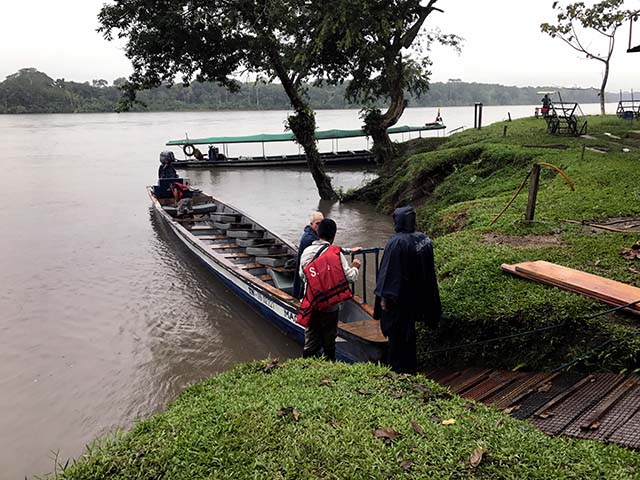
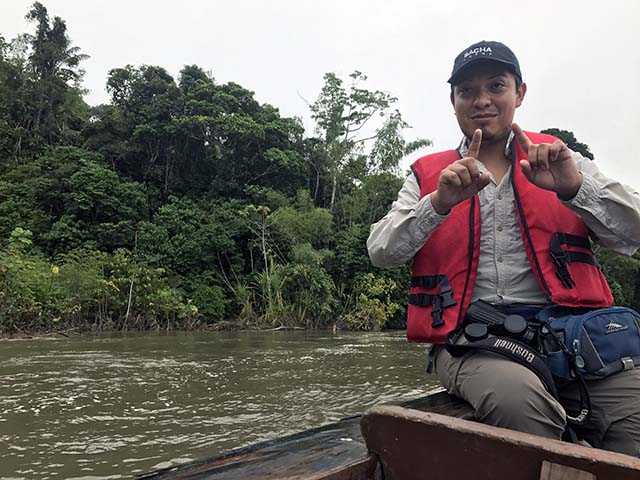
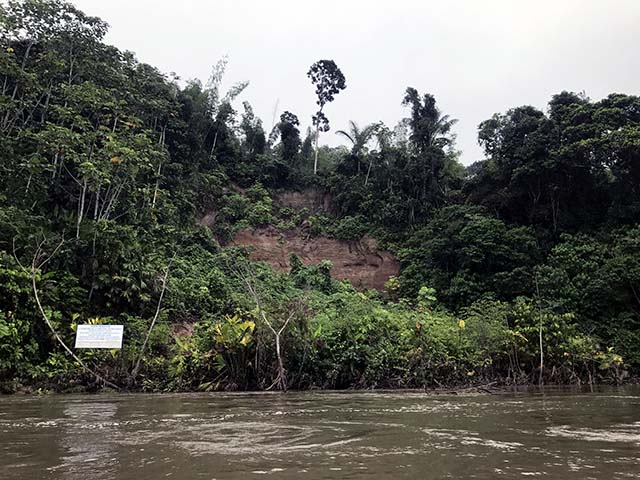
.jpg)

